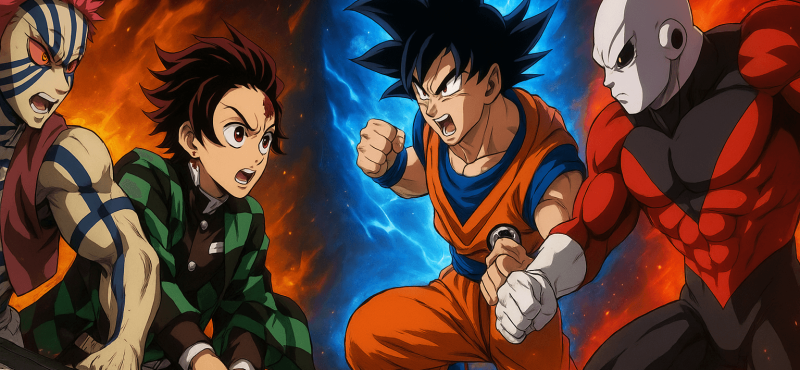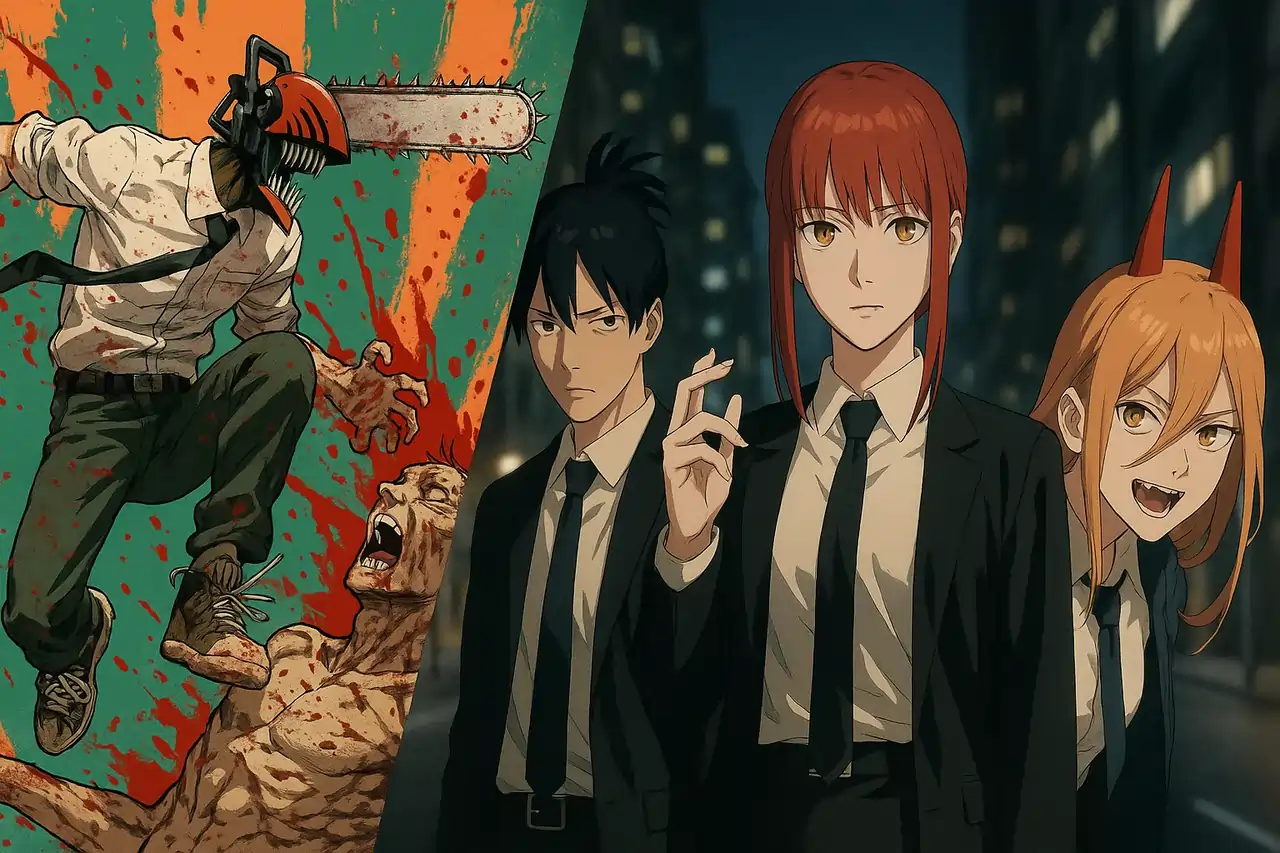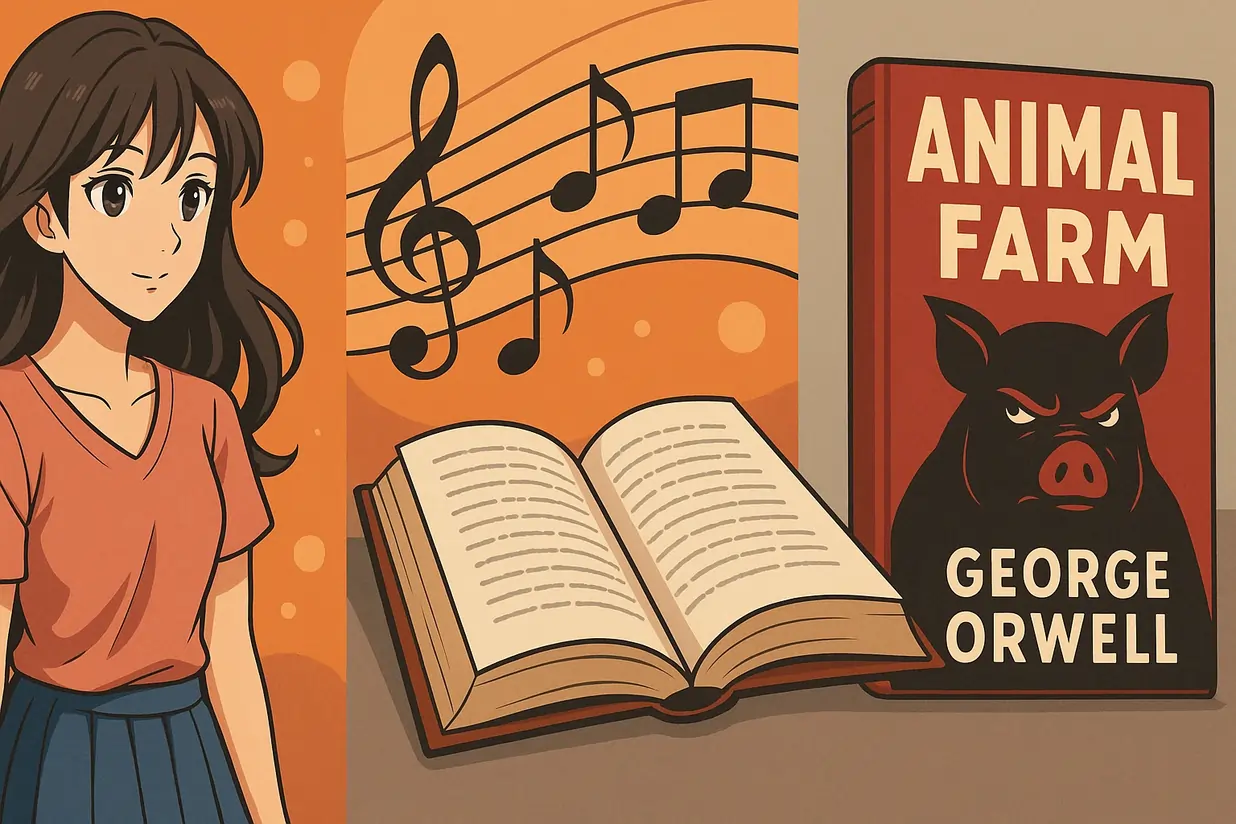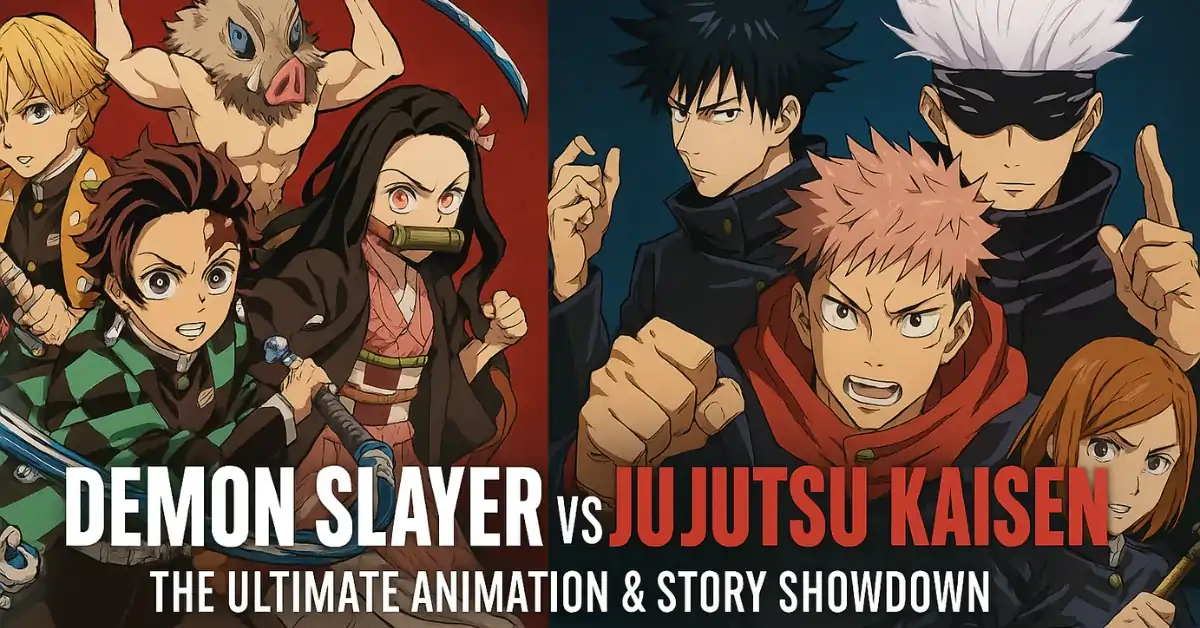Two Peak Shōnen Showdowns, One Hardcore Fan’s Deep-Dive
If you love combat that’s more than punches fights that argue about what strength means then these two clashes are the apex predators. On one side: Akaza vs. Tanjiro & Giyu inside the shifting Infinity Castle, a duel that welds technique to empathy until a demon remembers his name. On the other: Goku vs. Jiren in the Tournament of Power, a fireworks finale where technique becomes transcendence and the fate of universes rides on a heartbeat.
Below, I break both battles to the bone arena, stakes, philosophy, power systems, choreography, phase-by-phase beats, hype spikes, and emotional payload and then put them head-to-head. This isn’t a recap; it’s a love letter to two fights that define their series.
1) The Arenas as Characters
Infinity Castle A Living, Breathing Ring
The Infinity Castle doesn’t just hold the fight; it participates. Floors tilt, walls slide, geometry folds. Bad footwork gets punished immediately. The space is an accomplice to Akaza’s aggression and a foil for Giyu’s stillness and Tanjiro’s line-perfect entries. Every pivot, every misstep, every stance choice is magnified by a floor that can betray you. (Series canon anchors this setting during the Infinity Castle arc, where demon battles sprawl across Nakime’s labyrinth.)
World of Void The Tournament of Power Stage
By contrast, the World of Void strips everything away. No sky, no scenery only an arena that’s equal parts coliseum and chessboard, isolated under the gaze of gods. And the rules squeeze the fighters: no killing, no weapons, 48 minutes on the clock; lose your footing, you’re done. (The ToP time limit and rule set are series canon.)
Why it matters:
- Infinity Castle intensifies the micro balance, stance, breath, the philosophy in a step.
- World of Void amplifies the macro stakes, spectacle, time pressure, and the roar of a multiverse watching.
2) Stakes & Pressure
- Demon Slayer: Personal survival and moral truth. Every blade swing echoes the question, “What is strength for?” Akaza treats strength as religion; Tanjiro treats it as responsibility. The fight’s end can rewrite a soul. (Part 1 also frames this as one of several decisive Hashira battles inside the Castle.)
- Dragon Ball Super: The literal existence of entire universes. The ToP ring is a countdown device; the referee is time itself; gods stand when a mortal evolves. Goku’s Ultra Instinct isn’t just power it’s the franchise’s thesis about mastery under pressure. (UI debut and the finale episodes are anchored in DBS episodes 110, 130, 131.)
Verdict: Demon Slayer’s stakes are intimate and surgical; DBS is cosmic and explosive. Both are maximal in their own register.
3) Fighter Philosophies (The “Why” Behind Every Hit)
Akaza vs. Tanjiro & Giyu
- Akaza: Strength is sacred; the weak should either grow or get out of the way. He reads fighting spirit like a second sight (Compass Needle), turning intent into momentum. He’s not just a brute he’s a martial ascetic whose creed was forged by grief.
- Tanjiro: Strength exists to protect. He believes compassion can be disciplined into technique. His apex is Transparent World + selfless state lowering killing intent to zero so even a predator can’t feel him.
- Giyu: Still water; grief repurposed into control. Eleventh Form: Dead Calm is the art of subtraction removing turbulence so allies can breathe.
Goku vs. Jiren
- Jiren: Absolute faith in solitary strength. Power is the only truth that never betrays.
- Goku: Strength as limit-breaking curiosity and trust in others. Ultra Instinct (UI) isn’t just a form; it’s the mind releasing the body to move without thought discipline to the point of no-self. (UI omen first appears in Ep. 110; “Mastered Ultra Instinct” in Ep. 129; the final crescendo in Eps. 130–131.)
Verdict: Both walls of the ring are built from belief systems. Demon Slayer argues that empathy, perfectly trained, beats predation. DBS argues that mastery through selflessness, buttressed by trust, beats isolation.
4) Power Systems & How They Shape Choreography
Demon Slayer: Breath, Economy, and Presence Control
- Breathing Styles convert oxygen into speed and power, but the real secret is economy: remove flourish, keep only function.
- Transparent World lets Tanjiro see muscles and blood flow, predict weight shifts, and then erase his own presence. Akaza’s Compass Needle which reads aggressive intent fails when Tanjiro becomes “no one.” (Canon describes Transparent World in the Infinity Castle material; the Akaza duel highlights it.)
- Giyu’s Dead Calm neutralizes pressure itself attacks dissolve like rain on still water.
Dragon Ball Super: Ki, Godhood, and Autopilot Perfection
- Ultra Instinct separates mind and body: the body moves first, the mind observes. Omen (UI sign) teases the state; Mastered UI makes it symphonic. Debut and completion are etched in the episode progression (110 → 129 → 130/131).
- The World of Void encourages long tracking shots and enormous scale changes shockwaves carve the ring, gods in the stands react, the clock keeps screaming. (The ToP finale spans 130–131.)
TL;DR: Tanjiro’s win condition is disappearing from intent; Goku’s is disappearing from thought. Both are states of selflessness, but achieved through very different crafts.
5) Choreography & Cinematography: How the Hype is Built
- Demon Slayer: The camera respects footwork. Cuts linger long enough to read stance changes and breath rhythm, then snap when Akaza detonates. The Castle’s moving parts add risk to every entry. When Tanjiro decapitates, the kill line is clean, unglamorous geometry emotion comes after. (The arc in the film highlights Akaza’s demise and Tanjiro’s breakthrough.)
- DBS: The camera becomes a comet. Wide shots to sell scale, hard zooms to sell impact, and reaction cuts (angels, gods) to sell myth. Goku’s UI awakenings cue different palettes: Omen’s silver flicker → Mastered UI’s cold starwhite. The final episodes stage the most kinetic sakuga in the series’ run.
6) Phase-by-Phase: The Fights in Beats (with “time” as phases)
I’m using phases (early / mid / late / endgame) as “time markers” so you can map the hype curve cleanly without pausing a frame every minute.
A) Akaza vs. Tanjiro & Giyu Infinity Castle Phases
Opening (Phase 1):
Akaza arrives like a meteor. Tanjiro opens with Hinokami forms to test distance; Giyu establishes Dead Calm, flattening turbulence so they can think. Akaza’s Compass Needle starts reading their intent like it’s printed on their foreheads. (Akaza’s style and Giyu’s Eleventh Form are canon.)
Mid (Phase 2):
Tanjiro trims every extra movement. Giyu’s mark blooms; their duo rhythm tightens. Akaza keeps winning the information war until Tanjiro shifts from willpower to no-presence. Transparent World slides in like a whisper: muscles and blood flow become sheet music; Tanjiro’s aura goes silent. (Transparent World specifics are manga/canon.)
Late (Phase 3):
The cut. No flourish, no ego just a line through the neck, delivered by a body the enemy can’t “feel.” The panic is subtle: Akaza’s compass stutters for the first time in centuries.
Endgame (Phase 4):
Horror beat headless body tries to reattach. Giyu corrals the corpse; Tanjiro holds nerve. Then the memory cascade: Hakuji (the boy Akaza used to be), Keizo, Koyuki, the poisoned well, grief as origin-story. The choice that follows is not a stumble; it’s an act of will: Akaza rejects Muzan’s logic and ends himself. (These outcomes and the focus of Part 1 are widely reported in coverage of the Infinity Castle film.)
Hype spikes in this fight:
- Dead Calm’s first shimmer (philosophy-as-defense).
- Transparent World + selfless state (predator loses the scent).
- The clean neck-take (elegant, horrifying efficiency).
- The flashback knife: Hakuji’s past reframes the monster.
B) Goku vs. Jiren Tournament of Power Phases
Opening (Phase 1):
The arena stops to watch. Jiren shows gravity-well power; Goku stacks forms up to Spirit Bomb, which Jiren stonewalls. Pushed past the edge, Goku breaks into Ultra Instinct (Omen) for the first time (DBS Ep. 110). Gods notice and some stand. This is myth-level hype by design.
Mid (Phase 2):
Rematches pepper the tournament, but the weather report is constant: Jiren high-pressure system. Goku keeps refining the autonomous movement idea, inching toward a state where the body stops asking the mind for permission. (The road to MUI culminates in Ep. 129.)
Late (Phase 3):
Mastered Ultra Instinct. Silver hair, starwhite aura, and an attack/defense symphony where Goku simply is. The framing goes cosmic shockwaves carve the ring, gods react in awe. The series throws you into a storm cell made of sakuga (Ep. 130).
Endgame (Phase 4):
The last exchange is volcanic Jiren digs for a belief deeper than solitude; Goku reaches a limit even UI can’t sustain without consequence. The finish is the franchise distilled: teamwork in a series famous for solo ascension Frieza + 17 with Goku to close it out as the clock bleeds dry (Ep. 131).
Hype spikes in this fight:
- UI (Omen) debut the gods stand, the score does the heavy lifting.
- MUI reveal technique perfected as inevitability (Ep. 129 → 130).
- Final teamwork twist Android 17’s survival and trio finish as the buzzer sounds (Ep. 131).
7) The “Wow Elements” Compared
| Axis | Akaza vs. Tanjiro & Giyu (Demon Slayer) | Goku vs. Jiren (DBS) |
| Arena | Living labyrinth (Demon Slayer Infinity Castle) makes balance and angle a life-or-death skill. | World of Void is a void-for-spectacle: scale, shockwaves, gods in the rafters. |
| Clock/Time Pressure | Implicit fight flow + survival; tension from regeneration and spatial traps. | Hard 48-minute limit; clock as antagonist; elimination rules. |
| Technique Flex | Dead Calm (defense by erasure), Transparent World (presence control), Compass Needle (intent read). | UI Omen → Mastered UI (mindless body symmetry), Jiren’s sheer output. |
| Hype Construction | Quiet → razor; dignity of movement; tragedy shiv in the third act. | Loud → louder; music + reaction shots; meteors of sakuga in Eps. 130–131. |
| Emotional Payload | Redemption by choice; empathy trained into a killing line; Hakuji’s goodbye. | Trust vs. solitude; the most “Dragon Ball” thing ever: win together at the edge of extinction. |
8) Micro-Tech Moments that Live Rent-Free
- Tanjiro’s presence erasure: The instant Akaza’s Compass Needle loses the scent is the most “oh no, he solved it” moment in the Castle.
- Giyu’s Dead Calm: A defensive technique that feels like a hush; you hear silence as a weapon.
- MUI gait: Goku’s footwork becomes calligraphy; there’s no wind-up, only happening. (The run-up through Ep. 129, then explosion in 130.)
- Final Choice: Akaza’s self-erasure the strongest “wow” is an ethical one.
- Final Twist: Goku/Frieza/17 DB at its cheekiest and most sincere, sneaking teamwork into a series famous for solo ascents.
9) Sound & Color: The Invisible Weapons
- Demon Slayer: Color temperature maps ideology Akaza’s cold blue-white against Tanjiro’s warm ember orange, with Giyu’s steel desaturation in between. Strings and flutes thin out for Dead Calm and memory beats, reserving crescendo for realizations, not slashes. (Part 1’s cinematic treatment underlines these contrasts.)
- DBS: Percussion and choirs do heavy lifting for myth; you can practically hear divinity clock in when UI appears. The silver-white of MUI reads as a visual thesis: purity of motion, no wasted ink. Episodes 130–131 are an audiovisual victory lap.
10) The Heart of Each Fight (Why They Stay With You)
- Akaza vs. Tanjiro & Giyu:
You show up for choreography; you stay for Hakuji. The fight argues that compassion, disciplined into technique, can defeat predation and rescue what’s left of the predator. The “wow” is not the kill it’s the choice Akaza makes after. (That beat defines Part 1’s emotional spine.) - Goku vs. Jiren:
You show up for Ultra Instinct; you stay for DB’s spirit: rise, fail, rise again, and then let your friends carry the last inch. The form is divine, but the victory is human a team leaning into a deadline the size of a multiverse. (Eps. 130–131 seal it.)
11) Hardcore Head-to-Head (Scorecard by Axes that Matter)
Technical depth: Edge: Demon Slayer.
Presence control (Transparent World), intent-reading vs. intent-suppression, and environmental risk management create a truly martial argument.
Spectacle & myth: Edge: DBS.
Gods standing, time limits, universes at stake, and a visual language of bigness culminating in MUI.
Emotional devastation: Edge: Demon Slayer.
Akaza’s backstory and final agency hit where it hurts and heal where it counts.
Adrenaline high: Edge: DBS.
UI reveal → MUI crescendo → last-second team finish = cardiac salsa.
Philosophical clarity: Draw.
- Demon Slayer: “Strength is to protect.”
- DBS: “Strength is to surpass and to trust.”
Both are shōnen commandments, articulated at a level few series ever reach.
12) “Time” Readouts (Phase Timing Cheat-Sheet for Writers/Editors)
Use these phase markers if you want to place images, pull-quotes, or chapter headings in your blog.
Akaza vs. Tanjiro & Giyu
- Phase 1 (Opening): Castle shifts; Dead Calm debuts; Akaza’s Compass Needle dominates.
- Phase 2 (Mid): Tanjiro’s economy blossoms; Transparent World + selfless state achieved.
- Phase 3 (Late): Decapitation via presence erasure; body fights to reattach.
- Phase 4 (Endgame): Hakuji flashback; self-chosen end.
Goku vs. Jiren
- Phase 1 (Opening): Spirit Bomb standoff; UI (Omen) first awakens. (Ep. 110)
- Phase 2 (Mid): Refinement under the ticking clock; Jiren’s pressure is relentless.
- Phase 3 (Late): Mastered UI symphony. (Ep. 129→130)
- Phase 4 (Endgame): Team finish with Frieza & 17 as time expires. (Ep. 131)
13) Legacy & Rewatch Value
- Akaza vs. Tanjiro & Giyu: The rewatch isn’t to see if the cut lands it’s to catch the micro-cues that made it inevitable: how Tanjiro’s shoulders drop when the selfless state clicks; how Giyu’s blade economy carves silence; how Akaza’s face, for one breath, looks like a boy again. (Part 1’s film treatment spotlights this arc.)
- Goku vs. Jiren: The rewatch is a hype pilgrimage. UI Omen still gives goosebumps; MUI still feels like a law of nature switching on; the final tag-team still plays like Toriyama smiling at the camera. Episodes 110, 129–131 are appointment rewatching.
14) Why Anime Lovers Loved Each Fight
Akaza vs. Tanjiro & Giyu – For Anime Lovers
Anime fans adored this fight because it’s not just a clash of swords it’s a clash of philosophies. Every swing is purposeful, every stance tells a story, and every moment of silence screams tension. Hardcore fans love seeing a villain humanized Akaza’s tragic backstory woven into the choreography makes the fight more than a spectacle; it becomes emotional theater. The Infinity Castle setting, the fluid animation, and the meticulous attention to martial arts realism make every frame rewarding for fans who analyze movement, intent, and technique.
Key wow factors for anime lovers:
- Transparent World visualization (seeing the flow of muscles and intent).
- Dead Calm and Compass Needle as unique combat mechanics.
- Emotional depth behind each strike fighting is as much heart as blade.
- A climactic, philosophical conclusion where empathy triumphs.
Goku vs. Jiren – For Anime Lovers
Dragon Ball fans loved this fight for its sheer spectacle and escalation of power. Every punch and ki blast feels like a universe-shaking event. Hardcore anime lovers appreciate visual storytelling the pacing, the aura effects, the synchronized soundtrack, and the over-the-top sakuga animation at the climax. Goku’s mastery of Ultra Instinct and the teamwork finish elevate the battle from pure chaos to an epic narrative about trust, perseverance, and surpassing limits.
Key wow factors for anime lovers:
- Ultra Instinct animation and godly aura sequences.
- Universe-level stakes and dramatic tension built frame by frame.
- The perfect balance between raw power and strategic combat.
- Emotional payoff through Goku’s teamwork and Jiren’s philosophical growth.
Final Verdict (from one obsessed fan to another)
These two fights are cousins across universes. Tanjiro and Goku both win by becoming less of themselves one erases his presence, the other erases his thought. Giyu and Frieza/17 represent different kinds of help silent anchor vs. last-second alley-oop. Akaza and Jiren are opposite tragedies one saved by memory at the end, one almost saved by belief but not quite.
If you crave surgical martial storytelling that ends in catharsis, your crown jewel is Akaza vs. Tanjiro & Giyu. If you want a cosmic adrenaline sermon about mastery and trust under a dying clock, you go back to Goku vs. Jiren. The truth? We’re lucky enough to live in a timeline where we get both.




